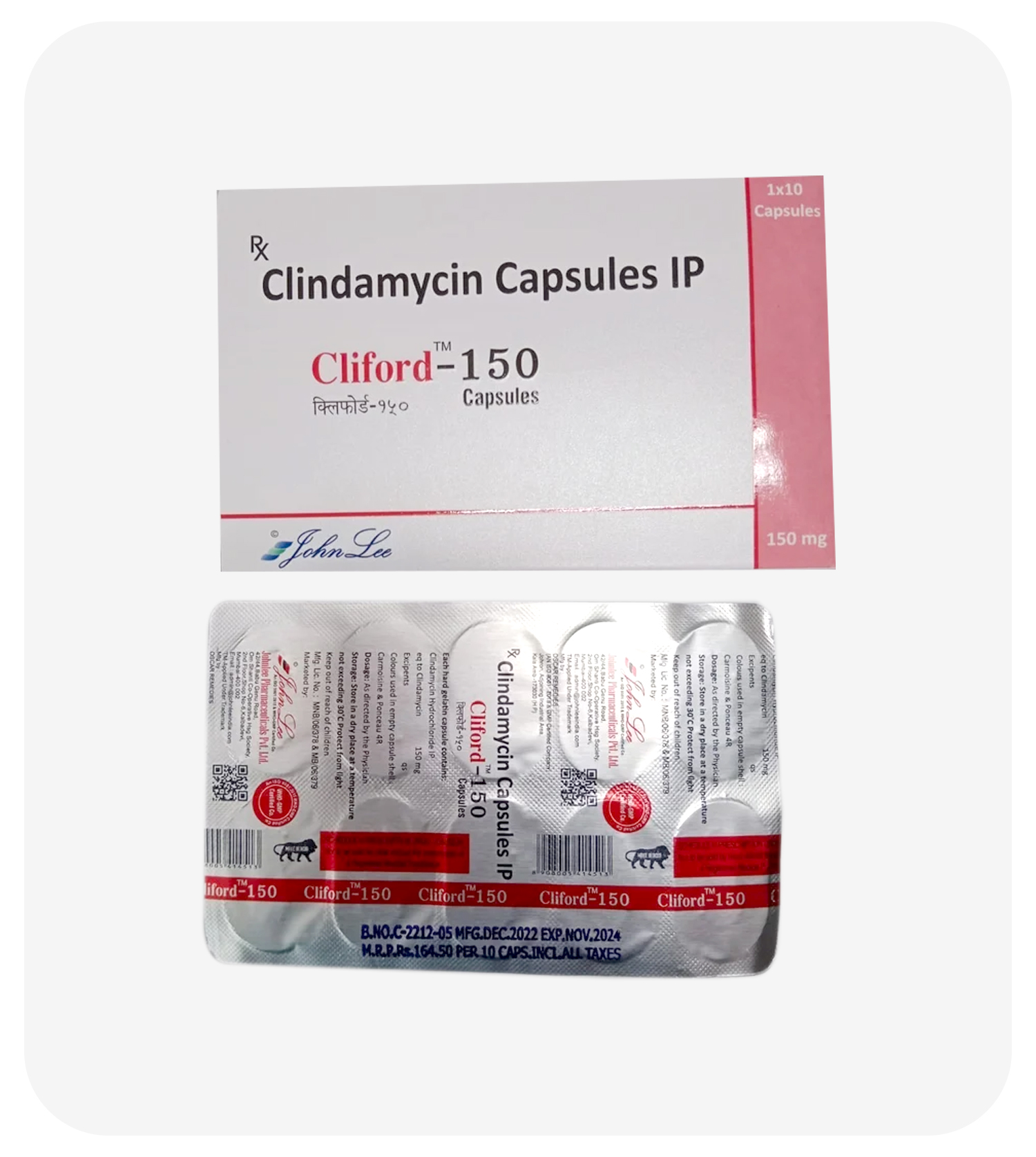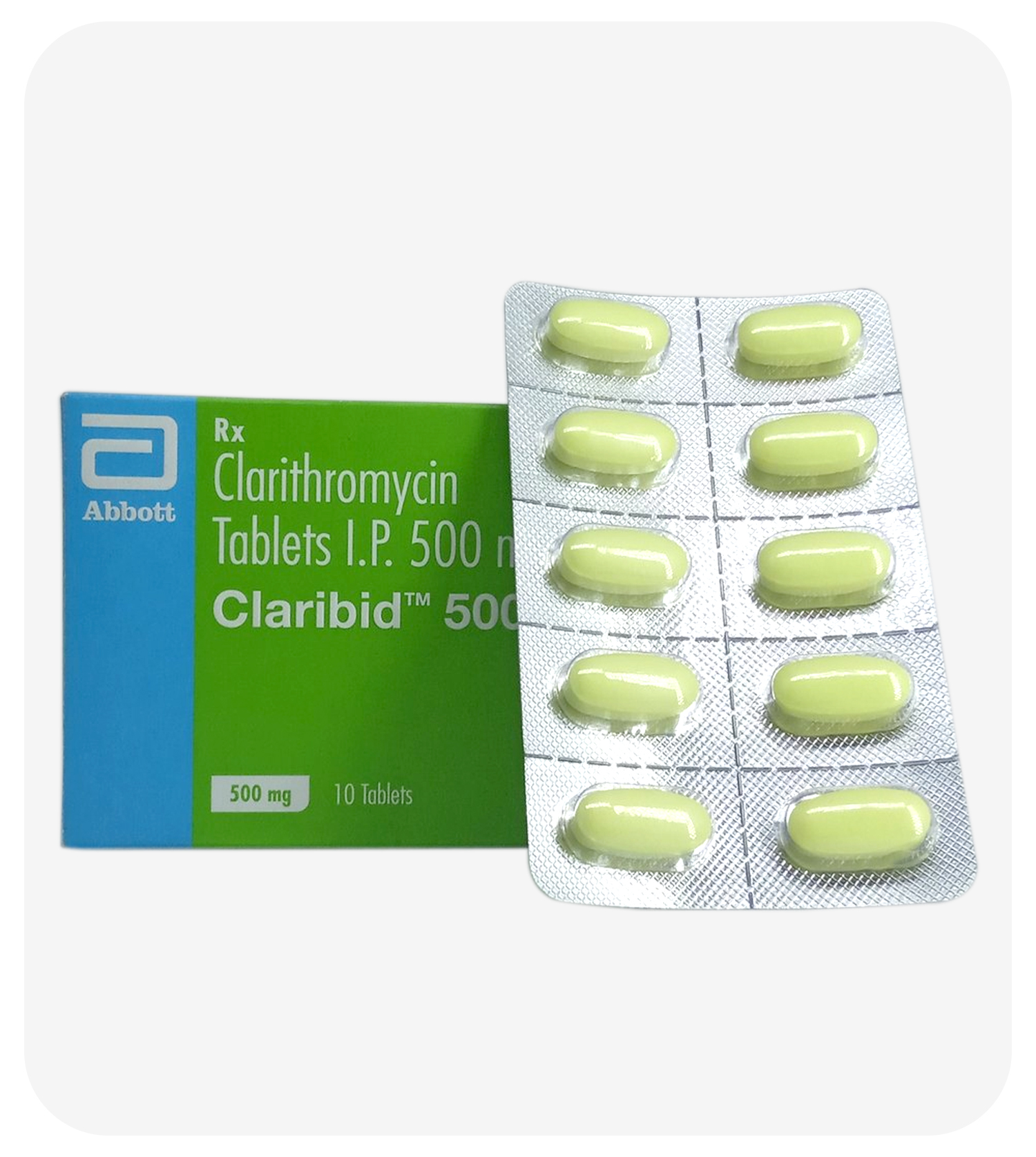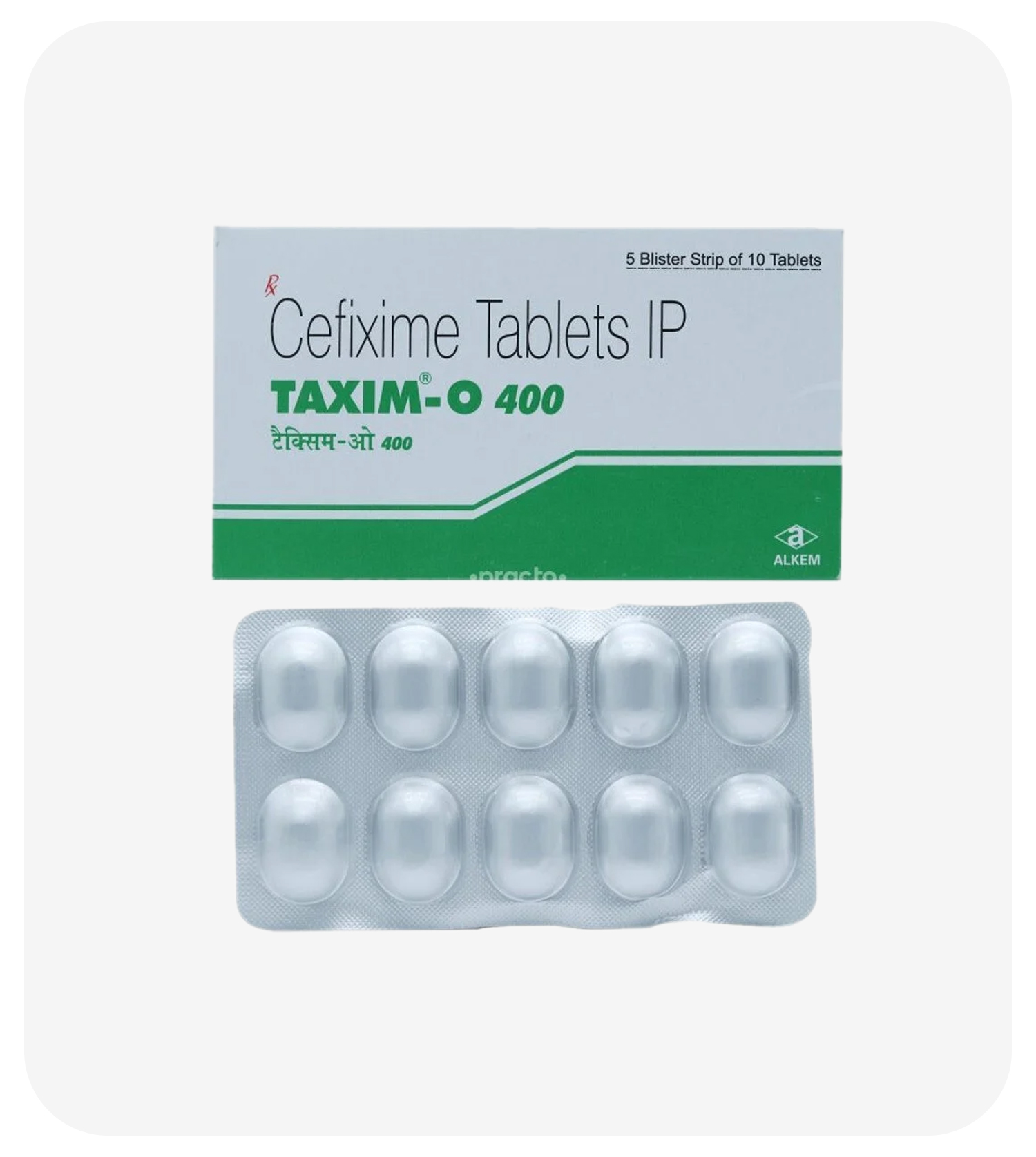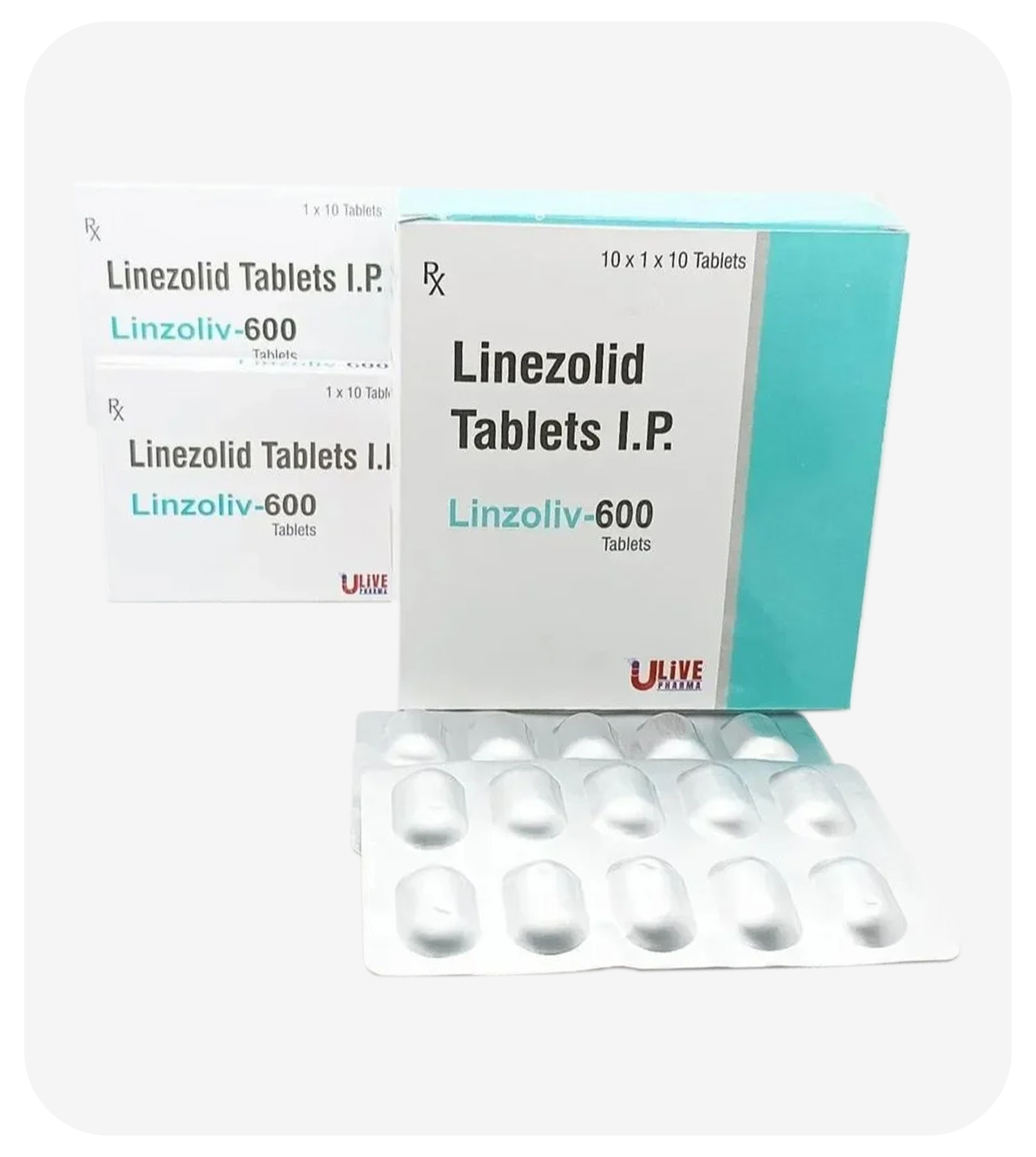Clindamycin
| 150 MG | |||
|---|---|---|---|
| Qty | Pack Price | Action | |
| 20 Tablets |
|
|
|
| 80 Tablets |
|
|
|
| 300 MG | |||
|---|---|---|---|
| Qty | Pack Price | Action | |
| 20 Tablets |
|
|
|
| 80 Tablets |
|
|
|
Clindamycin 150mg/300mg is an antibiotic used to treat a variety of bacterial infections, including skin, respiratory, and bone infections. It works by inhibiting bacterial protein synthesis, effectively stopping bacterial growth. You can buy Clindamycin 150mg/300mg online from trusted pharmacies. Always follow your healthcare provider’s guidance for proper dosage and usage to ensure safe and effective treatment.
Clindamycin: A Comprehensive Guide to Uses, Dosage, Side Effects, and More
Clindamycin is a versatile antibiotic used to treat a variety of bacterial infections. It belongs to a class of antibiotics known as lincosamides, and it is highly effective against gram-positive bacteria and certain anaerobic bacteria. Clindamycin is used for both oral and topical treatments, and it is often prescribed when other antibiotics are ineffective. This article will cover Clindamycin's uses, dosage, benefits, potential side effects, and other important information.
What is Clindamycin?
Clindamycin is an antibiotic that works by stopping the growth of bacteria. It inhibits bacterial protein synthesis by binding to the 50S ribosomal subunit. By doing this, it prevents the bacteria from producing the proteins they need to grow and replicate, ultimately killing or controlling the bacterial infection. Clindamycin is available in multiple forms, including:
- Oral tablets and capsules
- Topical creams and gels
- Intravenous (IV) injections
- Intramuscular (IM) injections
This medication is typically prescribed to treat serious bacterial infections, and is often used when other antibiotics are either ineffective or contraindicated. It can also be used to treat skin infections, bone infections, respiratory infections, and more.
How Does Clindamycin Work?
Clindamycin works by binding to the 50S subunit of bacterial ribosomes, which are responsible for synthesizing proteins. Without the ability to produce proteins, bacteria cannot grow, divide, or reproduce, thus allowing the body’s immune system to control the infection. Clindamycin is particularly effective against gram-positive bacteria, such as Staphylococcus aureus and Streptococcus species, as well as anaerobic bacteria, which are bacteria that thrive in environments without oxygen.
Common Uses of Clindamycin
Clindamycin is prescribed for a variety of bacterial infections, particularly those caused by gram-positive bacteria and anaerobic bacteria. Some of the most common uses include:
- Skin and Soft Tissue Infections: Clindamycin is often used to treat skin infections, such as cellulitis, abscesses, impetigo, and infected wounds. It is particularly effective in treating methicillin-resistant Staphylococcus aureus (MRSA), a type of bacteria resistant to many antibiotics.
- Bone and Joint Infections: Clindamycin is commonly prescribed for osteomyelitis (bone infections) and septic arthritis (joint infections) caused by susceptible bacteria. It works by targeting the infection and preventing the bacteria from multiplying in the affected area.
- Respiratory Tract Infections: Clindamycin is used to treat infections of the lungs, including pneumonia and lung abscesses, particularly when caused by bacteria that do not respond to other antibiotics.
- Dental Infections: Clindamycin can be used to treat dental abscesses or infections in the mouth, especially in cases where other antibiotics are not effective.
- Pelvic Inflammatory Disease (PID): In women, Clindamycin is often prescribed for pelvic inflammatory disease, which is an infection of the reproductive organs caused by bacteria like Chlamydia and Gonorrhea.
- Toxic Shock Syndrome: Clindamycin is sometimes used to treat toxic shock syndrome (TSS), a rare but potentially life-threatening condition caused by certain bacterial infections.
- Acne Treatment: Topical Clindamycin is widely used in the treatment of acne vulgaris. It works by reducing the inflammation caused by the bacteria that contribute to acne.
How to Take Clindamycin
Clindamycin can be taken in different forms, depending on the type of infection and its severity. Here are general guidelines for the oral and topical forms:
- Oral Clindamycin: The typical dosage for oral Clindamycin is 150 mg to 450 mg every 6 to 8 hours, depending on the infection being treated. Your healthcare provider will determine the appropriate dosage based on the severity of the infection and your overall health. The medication should be taken with a full glass of water to reduce the risk of irritation to the esophagus.
- Topical Clindamycin: Clindamycin topical gel or cream is usually applied to the affected area once or twice a day. It is important to follow the instructions provided by your healthcare provider for proper application.
- Intravenous Clindamycin: For more serious infections, intravenous (IV) Clindamycin may be administered in a hospital setting. The dosage and frequency of administration will be determined by a healthcare provider based on the type of infection.
It is important to complete the full course of Clindamycin as prescribed, even if symptoms improve before finishing the treatment. Stopping the medication too early can lead to the development of antibiotic-resistant bacteria.
Benefits of Clindamycin
Clindamycin provides several benefits, especially when treating infections that are difficult to manage with other antibiotics:
- Effective Against Resistant Infections: Clindamycin is particularly effective against drug-resistant bacteria, such as MRSA and VRE, making it an essential antibiotic in the fight against resistant infections.
- Wide Range of Applications: Whether used for skin infections, respiratory infections, or pelvic infections, Clindamycin can be applied to various types of bacterial infections, including those caused by anaerobic bacteria.
- Topical Application for Acne: Topical Clindamycin has proven to be highly effective for treating acne, particularly in patients with inflammatory acne lesions, by reducing bacteria and inflammation.
- Minimal Side Effects: Compared to other antibiotics, Clindamycin is generally well-tolerated, with fewer gastrointestinal side effects like nausea and diarrhea when used topically.
- Availability in Multiple Forms: Clindamycin is available in oral, topical, and injectable forms, allowing for flexible treatment options depending on the severity and type of infection.
Side Effects of Clindamycin
While Clindamycin is generally well-tolerated, some people may experience side effects. These can range from mild to severe and may include:
- Gastrointestinal Issues: Clindamycin is known to cause gastrointestinal disturbances, such as nausea, vomiting, diarrhea, and abdominal pain. These symptoms are more common when the drug is taken orally, especially with prolonged use.
- Clostridium difficile-associated Diarrhea (C. diff): One of the most serious side effects of Clindamycin is the risk of developing Clostridium difficile (C. diff) infection, a severe bacterial infection that causes watery diarrhea, abdominal cramping, and fever. If you experience these symptoms during or after Clindamycin treatment, it’s essential to contact your healthcare provider immediately.
- Skin Rash: Some individuals may develop a rash or itching at the site of application (for topical forms) or as a reaction to the oral medication.
- Liver Issues: Although rare, Clindamycin can cause liver toxicity, leading to symptoms like jaundice (yellowing of the skin or eyes) and dark urine. Liver function should be monitored during prolonged treatment.
- Allergic Reactions: Severe allergic reactions, including anaphylaxis, are rare but can occur with Clindamycin. Signs of an allergic reaction include swelling of the face, difficulty breathing, and hives. Seek emergency medical help if these symptoms occur.
Precautions and Warnings
Before taking Clindamycin, inform your healthcare provider about any pre-existing conditions, especially:
- History of gastrointestinal disease, particularly inflammatory bowel disease (such as Crohn's disease or ulcerative colitis)
- Liver disease
- Allergies to clindamycin or other lincosamide antibiotics
- Pregnancy or breastfeeding status (Clindamycin is generally considered safe in pregnancy but should only be used when clearly needed)
Drug Interactions with Clindamycin
Clindamycin may interact with certain medications, so it's important to inform your doctor about all the drugs you're taking, including prescription medications, over-the-counter drugs, and herbal supplements. Some notable drug interactions include:
- Muscle Relaxants: Clindamycin may enhance the effects of neuromuscular blocking agents, which are used in anesthesia. This could lead to respiratory complications.
- Other Antibiotics: Taking Clindamycin with certain other antibiotics, such as erythromycin, may reduce its effectiveness.
How to Store Clindamycin
Clindamycin should be stored according to the instructions provided with the prescription. In general, it should be stored at room temperature in a cool, dry place away from light and moisture. Keep all medications out of the reach of children.
Conclusion: Is Clindamycin Right for You?
Clindamycin is a highly effective antibiotic used to treat a wide range of bacterial infections, including skin infections, respiratory infections, and more. Its ability to combat drug-resistant bacteria and its availability in multiple forms make it a critical tool in modern medicine. However, like any medication, it’s important to use Clindamycin responsibly and under the guidance of a healthcare professional. If you’re prescribed Clindamycin, make sure to follow your healthcare provider’s instructions carefully, and monitor for any side effects or adverse reactions during treatment.
Submit Your Review
Your email address will not be published. Required fields are marked *







